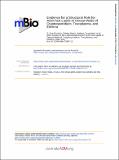Evidence for a Structural Role for Acid-Fast Lipids in Oocyst Walls of Cryptosporidium, Toxoplasma, and Eimeria
Author(s)
Bushkin, G. Guy; Motari, Edwin; Carpentieri, Andrea; Dubey, Jitender P.; Costello, Catherine E.; Samuelson, John; Robbins, Phillips W.; ... Show more Show less
DownloadBushkin-2013-Evidence for a struc.pdf (2.320Mb)
PUBLISHER_CC
Publisher with Creative Commons License
Creative Commons Attribution
Terms of use
Metadata
Show full item recordAbstract
Coccidia are protozoan parasites that cause significant human disease and are of major agricultural importance. Cryptosporidium spp. cause diarrhea in humans and animals, while Toxoplasma causes disseminated infections in fetuses and untreated AIDS patients. Eimeria is a major pathogen of commercial chickens. Oocysts, which are the infectious form of Cryptosporidium and Eimeria and one of two infectious forms of Toxoplasma (the other is tissue cysts in undercooked meat), have a multilayered wall. Recently we showed that the inner layer of the oocyst walls of Toxoplasma and Eimeria is a porous scaffold of fibers of β-1,3-glucan, which are also present in fungal walls but are absent from Cryptosporidium oocyst walls. Here we present evidence for a structural role for lipids in the oocyst walls of Cryptosporidium, Toxoplasma, and Eimeria. Briefly, oocyst walls of each organism label with acid-fast stains that bind to lipids in the walls of mycobacteria. Polyketide synthases similar to those that make mycobacterial wall lipids are abundant in oocysts of Toxoplasma and Eimeria and are predicted in Cryptosporidium. The outer layer of oocyst wall of Eimeria and the entire oocyst wall of Cryptosporidium are dissolved by organic solvents. Oocyst wall lipids are complex mixtures of triglycerides, some of which contain polyhydroxy fatty acyl chains like those present in plant cutin or elongated fatty acyl chains like mycolic acids. We propose a two-layered model of the oocyst wall (glucan and acid-fast lipids) that resembles the two-layered walls of mycobacteria (peptidoglycan and acid-fast lipids) and plants (cellulose and cutin).
IMPORTANCE Oocysts, which are essential for the fecal-oral spread of coccidia, have a wall that is thought responsible for their survival in the environment and for their transit through the stomach and small intestine. While oocyst walls of Toxoplasma and Eimeria are strengthened by a porous scaffold of fibrils of β-1,3-glucan and by proteins cross-linked by dityrosines, both are absent from walls of Cryptosporidium. We show here that all oocyst walls are acid fast, have a rigid bilayer, dissolve in organic solvents, and contain a complex set of triglycerides rich in polyhydroxy and long fatty acyl chains that might be synthesized by an abundant polyketide synthase. These results suggest the possibility that coccidia build a waxy coat of acid-fast lipids in the oocyst wall that makes them resistant to environmental stress.
Date issued
2013-09Department
Massachusetts Institute of Technology. Department of BiologyJournal
mBio
Publisher
American Society for Microbiology
Citation
Bushkin, G. G., E. Motari, A. Carpentieri, J. P. Dubey, C. E. Costello, P. W. Robbins, and J. Samuelson. “Evidence for a Structural Role for Acid-Fast Lipids in Oocyst Walls of Cryptosporidium, Toxoplasma, and Eimeria.” mBio 4, no. 5 (August 27, 2013): e00387-13.
Version: Final published version
ISSN
2150-7511